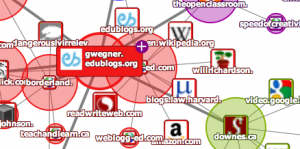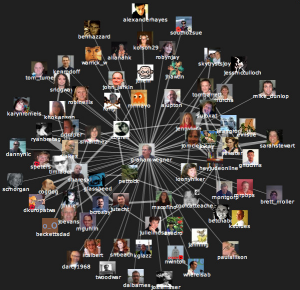We had a day trip to sunny (?!%) Melbourne today to attend a PD Workshop on the 1:1 laptop program following a f2f network connection made by my principal, Ann with the Coordinator Simon from St Albans Meadows Primary School at ULearn in October. Now I know there are successful 1:1 laptop programs all over the world but I had never really seen one in an Australian public school before. So after a delayed arrival into Tullamarine Airport and a quick taxi ride, my co-teaching buddies and I got to the school about ten minutes into the start of the presentation. Simon presented in his laid back but informative style, then we got to head into the classrooms to see the students using their laptops. There was a morning tea break and then he took us through the funding model and more importantly, the sort of work the students construct using their laptops. So, here are my notes from the session.
Interestingly, like our school, St Albans Meadows doesn't have a dedicated computing room - abandoned about four years ago. In a move to make most school technicians cringe in fear, Simon described their network as open without logons, passwords. Being transparent makes it easier to achieve learning goals as students are not spending time looking for the loopholes. The important thing is for students to have access to technology. He touched on the concept of 21st Century Learning and was somewhat bemused about this term considering we are just about finished with the first decade of that century. This opinion certainly rings true for me. He said that the school's perspective that it is about students engaging with the technology of this century. Right on cue, it was time to mention "Inquiry Based Learning" and he shared one of the Inquiry units titled "10 Ways To Save The Earth" where the students could show their learning in a number of ways including animations, raps and podcasts. The school also runs a program called Samoogle, based on the Google employees premise of 20% work time dedicated to employee's own learning. Students had been given this amount of time over half a term and had chosen to pursue a number of things - inventing a new sport, publishing a magazine, creating an animation, tutorial, clothing, rap/video clip, new game concept or a video storyboard.
Simon shared anecdotal teacher judgement data on student achievement, showing growth in stimulating learning, classroom behaviour and improved writing quality as judged against the VELS. Because the program has only been running in Year Five and Six, it hasn't been possible to ascertain any growth against the NAPLAN data (which is our Federal Minister's benchmark). The laptops have made an enormous difference to the struggling learners.
We then met another of the teachers, Travis. He talked about the concept of building a Learning Community (another topic dear to my heart) and how the laptop had impacted on their community. There was 100% uptake by parents, after surveying the parent community and flagging this program as the way forward. There has been increased opportunity to show work samples to inform parents and noticeably positive student attitude since the program's inception. The laptops don't go home every day - this is negotiated between the teacher and the student. It sounds obvious because it is true - a program like this starts with really good teachers to start with. The original concept was that the laptops would provide learning 24/7 but that has turned out that less is more. Laptops are not taken home during holidays and weekends as a general rule. This leads to the fantastic phrase:
Anywhere, anytime but not all the time.
Although the school has a number of IWBs installed across the school from a Victorian Education Department trial a few years back, they are not used for much more than projection screens. As Simon said, "Who needs interactivity on an IWB when the students have interactivity at their fingertips?" They use many Web 2.0 tools as well - VoiceThread, Wordle and a new one for me, Etherpad.
Simon talked next about the How? for their school. They worked to develope a culture that valued and recognised the importance of ICTs. There is an emphasis on thinking outside the square - circular desks in the classroom, power cords and power boards hanging from the ceiling. They have found that sharing is the best Professional Development. The average teacher doesn't have to be the keeper of all knowledge - they just have to know when to let the students have access to the right tools. The main message is focus on the curriculum and the pedagogy and let the kids drive the technology. He talked through their budgetary model which I won't outline here.
The teachers have also been provided with release for Inquiry planning of units. Each class has three major units and a smaller "Myself As A Learner" unit to start the year. This was provided via the Intel Teach program. We also saw examples of student ePortfolios using iWeb, which is hosted locally on each student's machine, and students can take their work off via a USB drive when they have to hand their laptop back to the school at the completion of primary school.
For more information on the St Albans Meadows program and 1:1 laptop learning in general, you can check out Simon's 1:1 Learning Ning.






